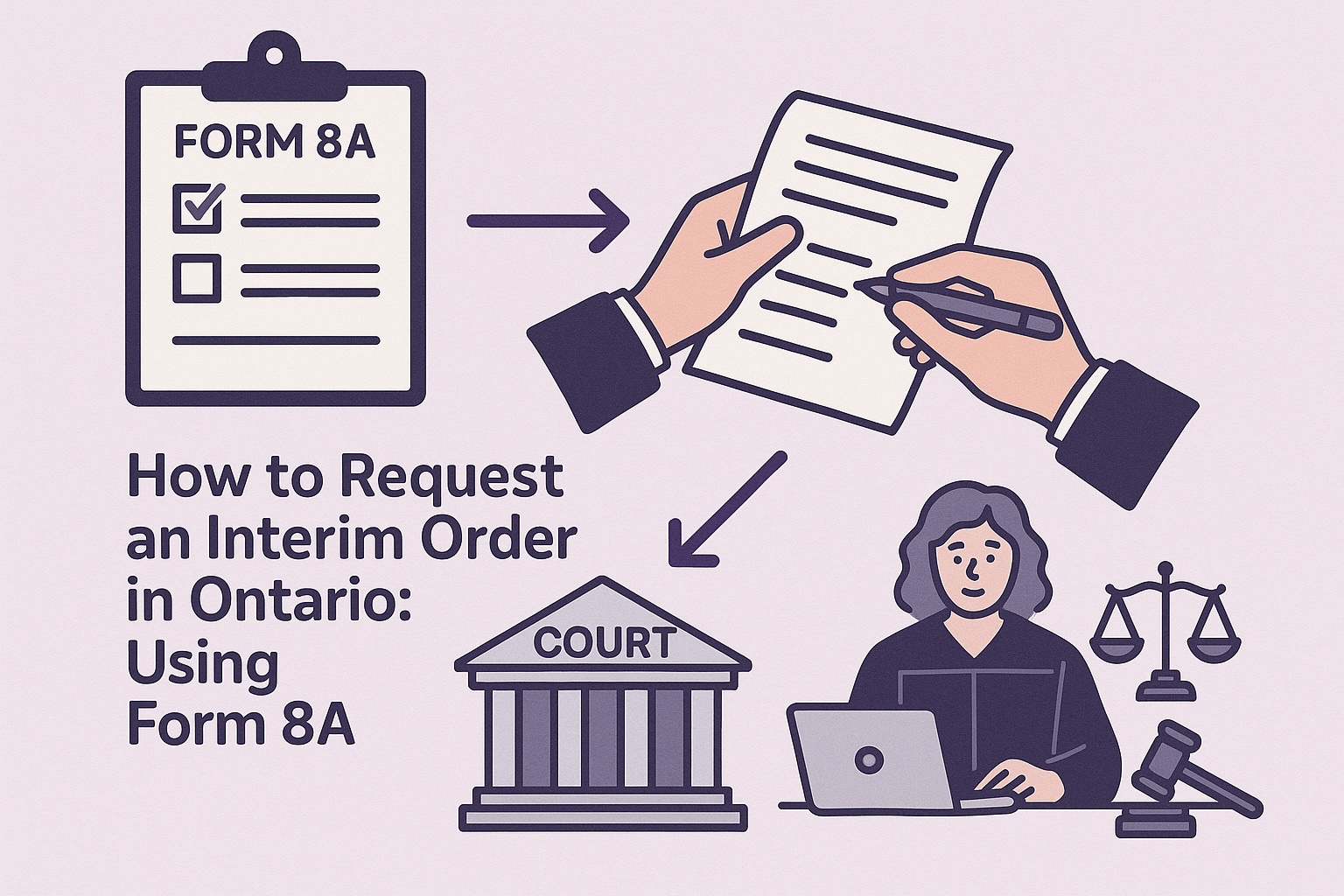How to Request an Interim Order in Ontario: Using Form 8A
Need urgent court relief during a family dispute in Ontario? Learn how to file Form 8A to request an interim order for restraining orders, custody, support, or exclusive possession of your home.

How to Request an Interim Order in Ontario: Using Form 8A
When urgent family law issues can’t wait for a full hearing, you can seek temporary relief—such as a restraining order, child support, or exclusive possession of your home—by filing an interim order application with Form 8A. This step-by-step guide explains what interim orders are, when to use them, and how to complete and file Form 8A in Ontario.
What Is an Interim Order?
An interim order is a temporary decision issued by a judge during ongoing family court proceedings. It ensures safety, financial support, and parenting arrangements remain in place until a final ruling:
-
Provides temporary protection (e.g., restraining orders)
-
Establishes custody or access to children
-
Grants exclusive possession of the family home
-
Orders spousal or child support pending trial
When to Request an Interim Order
File for an interim order if you face:
-
Immediate danger requiring a restraining order
-
Disputes over child custody/visitation
-
Need for exclusive possession of the family residence
-
Urgent support payments for yourself or children
-
Risk of irreparable harm or unfair disadvantage
Judges grant interim relief based on urgency and balancing hardships, not on final merits of the case.
Form 8A: Application (General)
-
Name: Form 8A – Application (General)
-
Purpose: To request interim orders in family law matters
-
Download: flr-8a-e.pdf
Completing Form 8A
- Identify Parties: Provide your name and the respondent’s name.
- Relief Requested: Clearly specify each interim order sought (e.g., restraining order under the Family Law Act, support under the Child Support Guidelines).
- Urgent Reasons: Detail facts showing why immediate relief is essential (dates, incidents, risks).
- Existing Orders: List any current court orders or agreements.
- Children’s Details: Include names, birth dates, and current parenting arrangements if applicable.
- Signature and Swearing: Sign before a commissioner for taking affidavits.
Related Forms You May Need
-
Form 35.1 – Affidavit in Support of Parenting Claims for custody or access disputes
-
Form 6B – Affidavit of Service to confirm the respondent has been served
-
Form 14B – Motion Form for scheduled interim motions or urgent motions
Filing and Serving Your Application
- File at Family Court: Submit Form 8A (and any supporting affidavits) in person or via the Ontario Family E-Filing Service.
- Request a Motion: Schedule a hearing using Form 14B for interim orders or ask the court clerk for an urgent motion slot.
- Serve the Respondent: Use Form 6B to prove service—personal or substituted service as permitted.
- Attend the Hearing: Present your evidence, highlight urgency, and address questions from the judge.
Duration of Interim Orders
-
Remain in effect until the next court date or until the judge issues a new interim or final order.
-
Depending on the docket, some interim orders can last several months.
Where to Get Help
-
Family Law Information Centres (FLIC): Free, on-site guidance in many courthouses.
-
Legal Aid Ontario: Apply at 1‑800‑668‑8258 for certificate coverage.
-
Community Legal Clinics: Local clinics offer family law advice and summary services.
-
Violence Against Women Shelters: May assist with urgent applications and safety planning.
Frequently Asked Questions (FAQs)
1. What is an "interim order" in Ontario family law?
An interim order is a temporary court order that puts rules in place to address urgent issues while you are in the middle of a family law case. It is not the final decision but serves as a bridge to provide stability until a final order or agreement is reached.
2. How is an interim order different from an emergency order?
While both are temporary, an "emergency order" is the most urgent type, often granted "ex parte" (without the other person present) for immediate safety. An "interim order" is also for urgent matters but typically involves a scheduled hearing where both parties have a chance to present their case.
3. What do I need to prove to get an interim order?
You need to convince the judge that there is an urgent need for the order and that it is necessary to make a decision now rather than waiting for a full trial. You must provide clear, factual evidence to support your request.
4. Do I have to use Form 8A to get an interim order?
Yes. Form 8A (Application) is the document that starts your entire family law case. Within that application, you will state the interim orders you are seeking. You then use a Motion Form (14B) to bring those specific interim issues before a judge for a decision.
5. How long does an interim order last?
An interim order lasts until a judge makes a different order or until your case is finalized through a trial or settlement. Depending on court backlogs, an interim order could be in place for many months.
6. Where can I get help with filing for an interim order?
The process is complex, and getting legal advice is highly recommended. You can contact Legal Aid Ontario to see if you qualify for a free lawyer, speak to duty counsel at the courthouse for on-the-spot advice, or hire a family lawyer privately.
